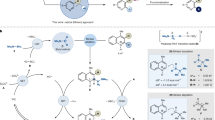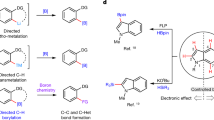Abstract
The ability to form multiple carbon–carbon bonds in a controlled sequence and thus rapidly build molecular complexity in an iterative fashion is an important goal in modern chemical synthesis. In recent times, transition-metal-catalysed coupling reactions have dominated in the development of C–C bond forming processes. A desire to reduce the reliance on precious metals and a need to obtain products with very low levels of metal impurities has brought a renewed focus on metal-free coupling processes. Here, we report the in situ preparation of reactive allylic and benzylic boronic acids, obtained by reacting flow-generated diazo compounds with boronic acids, and their application in controlled iterative C–C bond forming reactions is described. Thus far we have shown the formation of up to three C–C bonds in a sequence including the final trapping of a reactive boronic acid species with an aldehyde to generate a range of new chemical structures.
This is a preview of subscription content, access via your institution
Access options
Subscribe to this journal
Receive 12 print issues and online access
$259.00 per year
only $21.58 per issue
Buy this article
- Purchase on Springer Link
- Instant access to full article PDF
Prices may be subject to local taxes which are calculated during checkout




Similar content being viewed by others
References
Kumara, R. & Van der Eycken, E. V. Recent approaches for C–C bond formation via direct dehydrative coupling strategies. Chem. Soc. Rev. 42, 1121–1146 (2013).
Burns, M. et al. Assembly-line synthesis of organic molecules with tailored shapes. Nature 513, 183–188 (2014).
Li, J. et al. Synthesis of many different types of organic small molecules using one automated process. Science 347, 1221–1226 (2015).
Lo, J. C., Gui, J., Yabe, Y., Pan, C.-M. & Baran, P. S. Functionalized olefin cross-coupling to construct carbon–carbon bonds. Nature 516, 343–348 (2014).
Mlynarski, S. N., Schuster, C. H. & Morken, J. P. Asymmetric synthesis from terminal alkenes by cascades of diboration and cross-coupling. Nature 505, 386–390 (2014).
Hartwig, J., Metternich, J. B., Nikbin, N., Kirschning, A. & Ley, S. V. Continuous flow chemistry: a discovery tool for new chemical reactivity patterns. Org. Biomol. Chem. 12, 3611–3615 (2014).
Miyaura, N. & Suzuki, A. Palladium-catalyzed cross-coupling reactions of organoboron compounds. Chem. Rev. 95, 2457–2483 (1995).
Liu, C., Zhang, H., Shi, W. & Lei, A. Bond formations between two nucleophiles: transition metal catalyzed oxidative cross-coupling reactions. Chem. Rev. 111, 1780–1824 (2011).
Johansson-Seechurn, C. C. C., Kitching, M. O., Colacot, T. J. & Snieckus, V. Palladium-catalyzed cross-coupling: a historical contextual perspective to the 2010 Nobel prize. Angew. Chem. Int. Ed. 51, 5062–5085 (2012).
Jana, R., Pathak, T. P. & Sigman, M. S. Advances in transition metal (Pd, Ni, Fe)-catalyzed cross-coupling reactions using alkyl-organometallics as reaction partners. Chem. Rev. 111, 1417–1492 (2011).
Tellis, J. C., Primer, D. N. & Molander, G. A. Single-electron transmetalation in organoboron cross-coupling by photoredox/nickel dual catalysis. Science 345, 433–436 (2014).
Molander, M. A., Traister, K. M. & O'Neill, B. T. Reductive cross-coupling of nonaromatic, heterocyclic bromides with aryl and heteroaryl bromides. J. Org. Chem. 79, 5771–5780 (2014).
Phipps, R. J. & Gaunt, M. J. A meta-selective copper-catalyzed C–H bond arylation. Science 323, 1593–1597 (2009).
Hunt, A. J., Matharu, A. S., King, A. H. & Clark, J. H. The importance of elemental sustainability and critical element recovery. Green Chem. 17, 1949–1950 (2015).
Matteson, D. S. Boronic esters in asymmetric synthesis. J. Org. Chem. 78, 10009–10023 (2013).
Hall, D. G. Boronic Acids: Preparation and Applications in Organic Synthesis, Medicine and Materials Vol. 2 (Wiley-VCH, 2011).
Barluenga, J., Thomás-Gamaza, M., Aznar, F. & Valdés, C. Metal-free carbon–carbon bond-forming reductive coupling between boronic acids and tosylhydrazones. Nature Chem. 1, 494–499 (2009).
Allwood, D. M., Blakemore, D. C., Brown, A. D. & Ley, S. V. Metal-free coupling of saturated heterocyclic sulfonylhydrazones with boronic acids. J. Org. Chem. 79, 328–338 (2014).
Nakagawa, S. et al. Application of Barluenga boronic coupling (BBC) to the parallel synthesis of drug-like and drug fragment-like molecules. ChemMedChem. 7, 233–236 (2012).
Kupracz, L. & Kirschning, A. Two-step flow synthesis of biarylmethanes by reductive arylation of tosylhydrazones. J. Flow Chem. 3, 11–16 (2013).
Tran, D. N., Battilocchio, C., Lou, S. B., Hawkins, J. M. & Ley, S. V. Flow chemistry as a discovery tool to access sp2–sp3 cross-coupling reactions via diazo compounds. Chem. Sci. 6, 1120–1125 (2015).
Bonet, A., Odachowski, M., Leonori, D., Essafi, S. & Aggarwal, V. K. Enantiospecific sp2–sp3 coupling of secondary and tertiary boronic esters. Nature Chem. 6, 584–589 (2014).
Rasappan, R. & Aggarwal, V. K. Synthesis of hydroxyphthioceranic acid using a traceless lithiation–borylation–protodeboronation strategy. Nature Chem. 6, 810–814 (2014).
Balieu, S. et al. Toward ideality: the synthesis of (+)-kalkitoxin and (+)-hydroxyphthioceranic acid by assembly-line synthesis. J. Am. Chem. Soc. 137, 4398–4403 (2015).
Roesner, S., Blair, D. J. & Aggarwal, V. K. Enantioselective installation of adjacent tertiary benzylic stereocentres using lithiation–borylation–protodeboronation methodology. Application to the synthesis of bifluranol and fluorohexestrol. Chem. Sci. 6, 3718–3723 (2015).
Woerly, E. M., Roy, J. & Burke, M. D. Synthesis of most polyene natural product motifs using just twelve building blocks and one coupling reaction. Nature Chem. 6, 484–491 (2014).
Davies, A. G., Roberts, B. P. & Ramsay, W. Peroxides of elements other than carbon. Part XIP the autoxidation of optically active I–phenylethylboronic acid. J. Chem. Soc. B 17–22 (1967).
Snyder, H. R., Kuck, J. A. & Johnson, J. R. Organoboron compounds, and the study of reaction mechanisms. Primary aliphatic boronic acids. J. Am. Chem. Soc. 60, 105–111 (1938).
Sun, J., Perfetti, M. T. & Santos, W. L. A method for the deprotection of alkylpinacolyl boronate esters. J. Org. Chem. 76, 3571–3575 (2011).
Raducan, M., Alam, R. & Szabó, K. J. Palladium-catalyzed synthesis and isolation of functionalized allylboronic acids: selective, direct allylboration of ketones. Angew. Chem. Int. Ed. 51, 13050–13053 (2012).
Esumi, T., Yamamoto, C. & Fukuyama, Y. A short synthesis of (+)-bakuchiol. Synlett 24, 1845–1847 (2013).
Acknowledgements
The authors acknowledge Pfizer (C.B., D.M.A. and D.C.B.), the Studienstiftung des deutschen Volkes (German National Academic Foundation, F.F.), the Alexander-von-Humboldt foundation (A.H.), Erasmus+ (M.S.), the Swiss National Science Foundation (D.N.T.) and the EPSRC (S.V.L., grants nos. EP/K009494/1 and EP/M004120/1) for financial support. The authors thank J.M. Hawkins for discussions and R.M. Turner for providing assistance throughout the development of the research programme.
Author information
Authors and Affiliations
Contributions
C.B., D.N.T. and S.V.L. conceived the project. C.B., A.H. and S.V.L. designed the experiments. C.B., F.F., A.H., M.S. and D.N.T. performed the experiments. D.M.A. analysed the data and prepared the supporting information. D.C.B. provided crucial information for the development of the project. C.B., A.H. and S.V.L. wrote the paper.
Corresponding authors
Ethics declarations
Competing interests
The authors declare no competing financial interests.
Supplementary information
Supplementary information
Supplementary information (PDF 12847 kb)
Rights and permissions
About this article
Cite this article
Battilocchio, C., Feist, F., Hafner, A. et al. Iterative reactions of transient boronic acids enable sequential C–C bond formation. Nature Chem 8, 360–367 (2016). https://doi.org/10.1038/nchem.2439
Received:
Accepted:
Published:
Issue Date:
DOI: https://doi.org/10.1038/nchem.2439
This article is cited by
-
Use of trifluoroacetaldehyde N-tfsylhydrazone as a trifluorodiazoethane surrogate and its synthetic applications
Nature Communications (2019)
-
Expanding the medicinal chemistry synthetic toolbox
Nature Reviews Drug Discovery (2018)
-
Probing intermediates of the induction period prior to nucleation and growth of semiconductor quantum dots
Nature Communications (2017)
-
Flow chemistry and polymer-supported pseudoenantiomeric acylating agents enable parallel kinetic resolution of chiral saturated N-heterocycles
Nature Chemistry (2017)
-
An autonomous organic reaction search engine for chemical reactivity
Nature Communications (2017)



